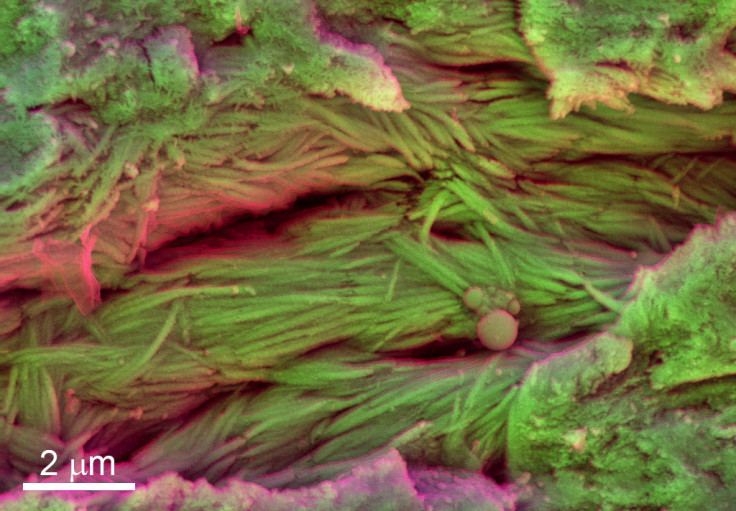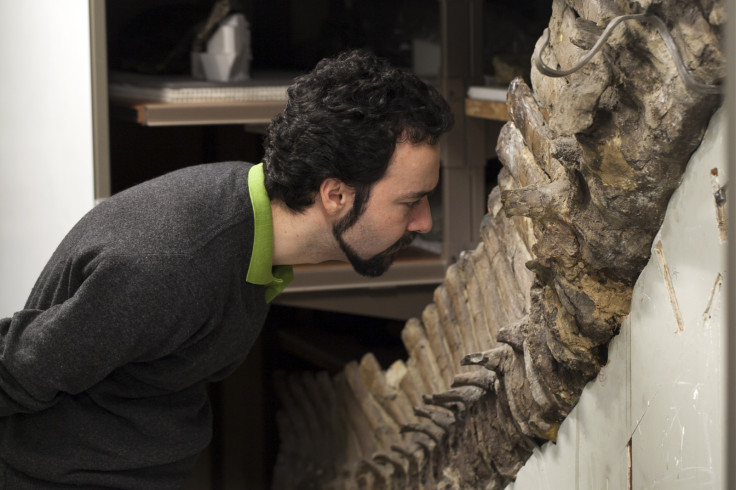Blood cells and collagen discovered in 75 million-year-old dinosaur bones by chance

Soft tissues have been discovered in poorly preserved dinosaur fossils dating back 75 million years.
The red blood cells and collagen were found in eight dinosaur bones by chance by Sergio Bertazzo and Susannah Maidment, both from Imperial College London.
Previously, soft tissues have been found in fossils tens of millions of years old but these were only in specimens that had been exceptionally well preserved, and their identification remained controversial. It is widely thought protein molecules cannot be preserved any longer than four million years.
Maidment told IBTimes UK that she and Bertazzo had decided to look at dinosaur bones on the nano-scale just to see what they saw. Museum curators provided them with eight fairly poorly-preserved fossil fragments: "We didn't see any of the things we were hoping to see. But what we did see was this soft tissue in depth. I was extremely sceptical when Sergio told me what he'd seen when he first put these things under the microscope.
"I thought there must be another explanation. That it was bacteria, or pollen or modern contamination. We went into it with a great deal of scepticism then attempted to eliminate every other possibly hypothesis there could possibly be."
Publishing their findings in the journal Nature Communications, the scientists say their work may be the first step towards better understanding dinosaurs – answering key questions about their lifestyles and whether they were warm or cold blooded.
The specimens studied included a claw, which had what they believe to be red blood cells. While they do not know the species, Maidment said it was a meat eating dinosaur, possibly a gorgosaurus. In another fragment of rib bone, they found a banded structure similar to modern day collagen fibres. Collagen can be used to identify related creatures, allowing a fingerprint that would provide a far clearer dinosaur family tree.
"I think one of the key things from the blood cells is that there's very well constrained relationship to do with metabolic rate and blood cells size among vertebrates," Maidment said. "Within specific vertebrate groups, the smaller the blood cells the faster the metabolic rate. Animals with a faster metabolic rate tend to be warm blooded. Whereas those with a slow metabolic rate tend to be cold blooded.
"The ancestors of dinosaurs are thought to have been cold blooded animals, while birds' descendants are warm blooded, so somewhere along that evolutionary lineage, from proto dinosaurs up through to birds, you've got the evolution of warm bloodedness.
"That's been a subject of interest among palaeontologists for some time because if they were warm blooded, that gives you the idea that these are very active, very bird like animals. And perhaps much more bird like than they were reptilian. If they were cold blooded that gives us more this reptilian idea of their behaviour, their habits and lifestyles."

She said that bones do not give much indication as to whether a dinosaur was cold or warm blooded, so having access to blood cells would allow scientists to work out if the animals were likely to have had a faster or slower metabolic rate – and when warm blood began to evolve.
Bertazzo and Maidment also used an ion mass spectrometer to compare the ancient soft tissue with a blood sample from an emu, allowing them to compare the samples to see if there were similarities in the organic signatures.
"We simply wanted to compare the red blood cells morphologically and chemically to a living dinosaur if you like to see if the chemistry and shapes are the same," she said. "The cells looks similar but the emu cells are much larger. But that's not a particular concern because there's a very large size range among vertebras and also ours would have shrunk because they've been in the ground for 75 million years. We wouldn't expect them to be their original fleshed out size. Chemically we were able to show there was a surprising similarity between whole emu blood and the dinosaur blood."

The team now hopes to analyse more fossils to see if they can find more soft tissue in a wider range of specimens in order to fully verify their findings. "We've had to apply a certain degree of scepticism, but neither Sergio nor I can come up with any other explanation for what they are. To verify them we need to look at more specimens of the same age from the same burial environment.
"We then want to go back in time – how far back in time does this preservation go? And we want to look at different types of burial environments – these rocks were deposited by rivers and flood plains. Do we also see the same preservation in rocks that were deposited by the sea?"
Bertazzo said: "If we can confirm that our initial observations are correct, then this could yield fresh insights into how these creatures once lived and evolved."
© Copyright IBTimes 2025. All rights reserved.






















